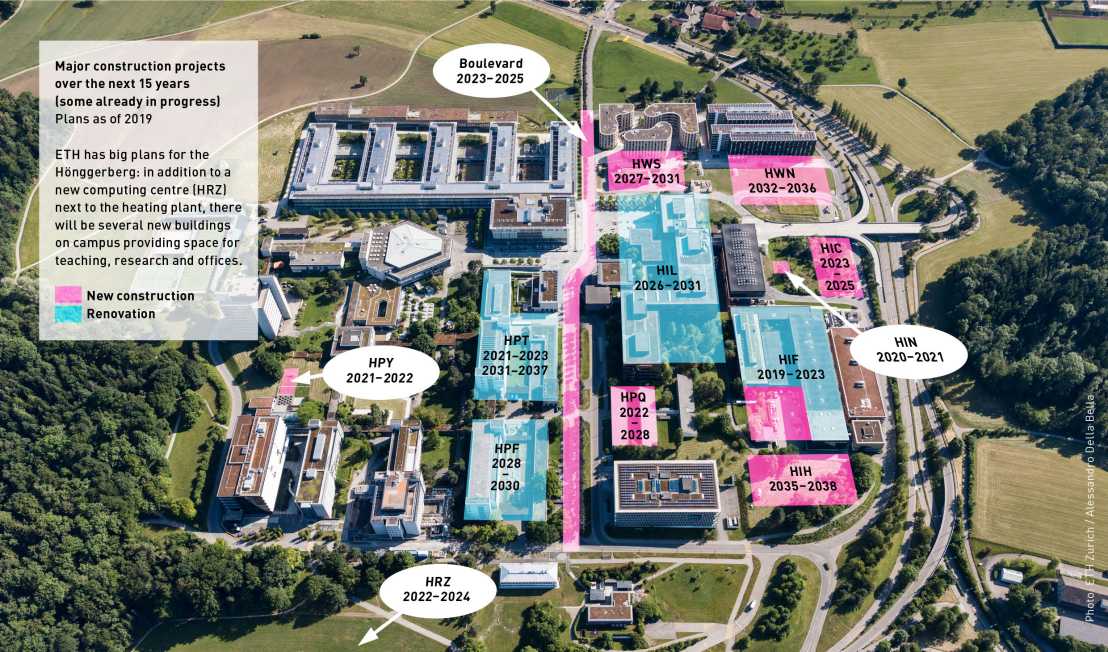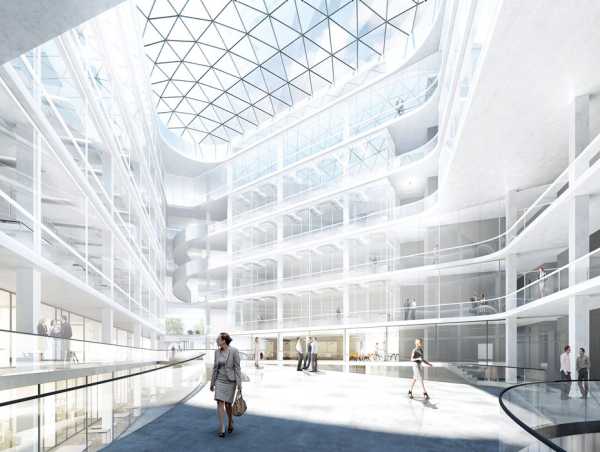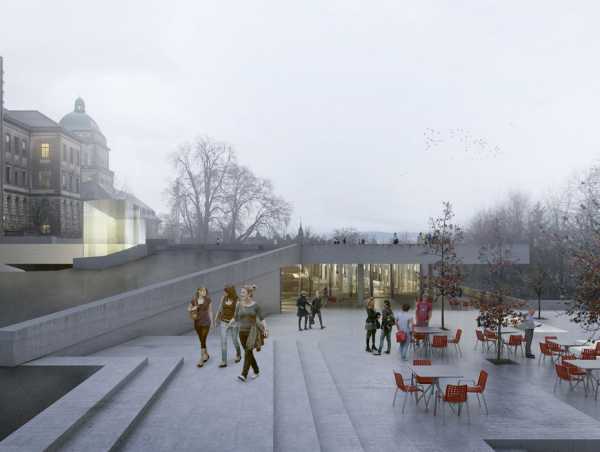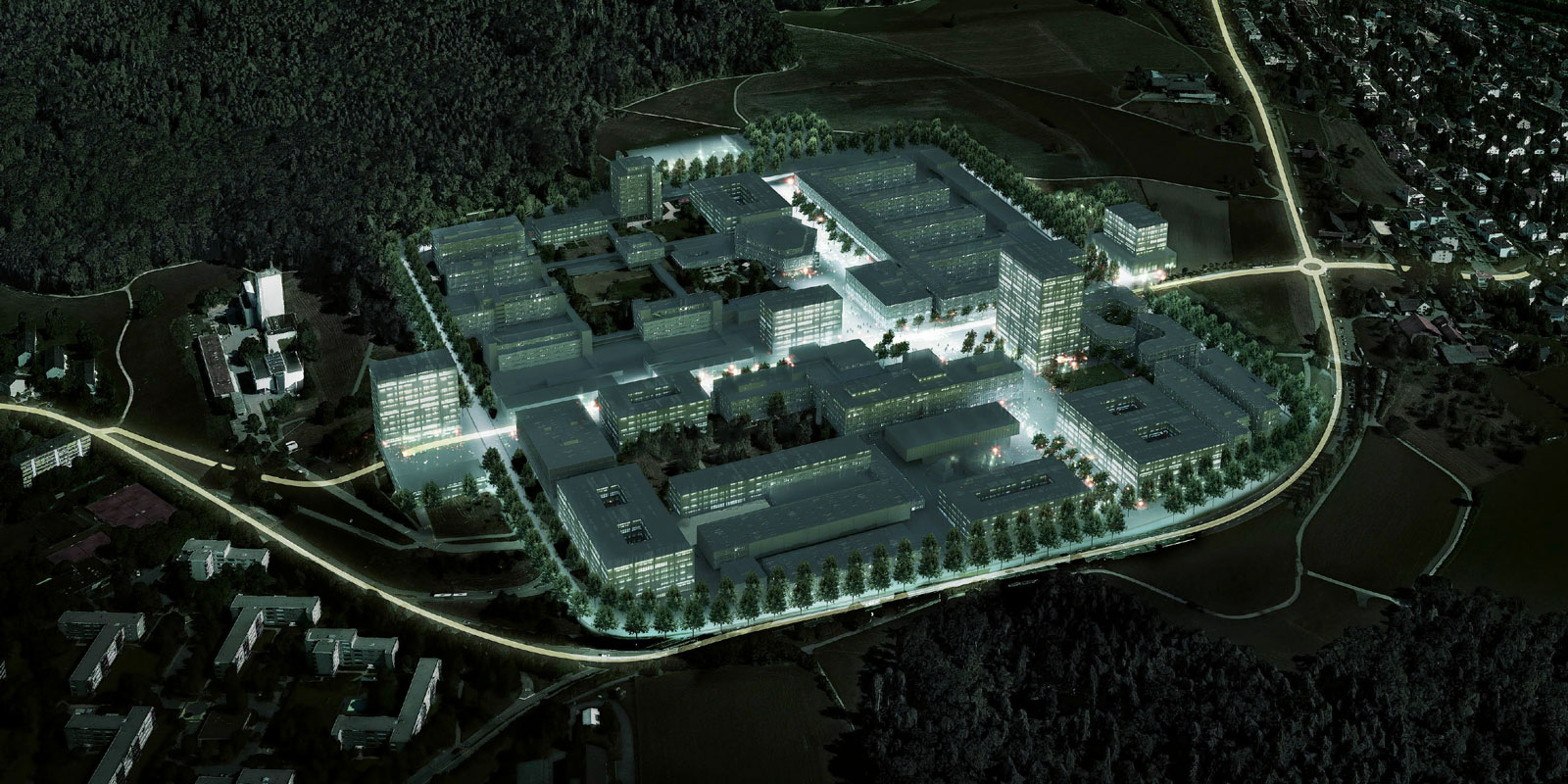The Campus Hönggerberg 2040 project lays out a vision for the ETH campus of the future. At the same time, however, space is becoming increasingly scarce for ETH. Why is that? And how can we overcome this challenge in order to create inspiring workplaces?
If you’ve visited an ETH Zurich campus recently, you’ve surely noticed the amount of construction work going on. On the Hönggerberg campus, ETH Zurich is renovating the HIF building, which opened in 1976 and houses the Department of Civil, Environmental and Geomatic Engineering (D-BAUG). The building is also being expanded to include a multipurpose hall and additional laboratory facilities, all of which can be adapted flexibly to accommodate new research topics and technologies. The new laboratory facilities will bring together all nine environmental engineering professorships in the same space for the first time. New meeting areas will also be created in order to encourage academic discussion and the exchange of ideas.
Promoting collaboration is also one of the key principles of the new GLC teaching and research building, which is currently under construction on the Zurich Zentrum campus and will be used for work in the fields of health sciences and medical technology (D-HEST, D-ITET). The building includes laboratories for both new and existing professorships as well as research infrastructures which will enable collaboration with the University of Zurich and the hospitals. It will also provide new seminar rooms and workspaces for students.
Interdisciplinary exchange is championed on the Schällemätteli Life Sciences Campus in Basel as well, where ETH is building the BSS laboratory and research building for systems biology and synthetic biology (D-BSSE). The aim is to create a bright, pleasant space that people enjoy spending time in – in line with the new ETH real estate strategy focusing on the creation of inspiring environments.
In total, the three construction projects will provide 35,250 square metres of additional space for teaching, research and knowledge transfer. That’s the size of nearly 138 tennis courts! It’s a significant amount of space – but it’s still just a drop in the ocean.
Growth constrained by structural limitations

ETH Vice President Ulrich Weidmann highlighted the issue recently, explaining that available space is going to be in increasingly short supply in the near future: “We will have to get used to the fact that academic growth will be determined by the accommodation options available,” said Weidmann, whose domain in the Executive Board includes real estate-related matters. “In the next ten years, the construction rate, building refurbishments and leasing options will all play a part in determining which appointments we can make and when.”
ETH Zurich has approximately 490,000 square metres of usable space at its disposal in around 200 buildings – 8 times the area of the Louvre in Paris. But space is highly sought after. In the city of Zurich, for example, the available building area is growing scarce while the residential population continues to increase. ETH Zurich’s space reserves are slowly running out too, particularly on the Zentrum campus: “There is hardly any free space left for new buildings on the Zentrum campus and, once the new GLC building is finished, we will have to focus on refurbishing existing buildings,” says Daniel Bucheli, Director of Real Estate Management at ETH.
The lack of space is down to the fact that the number of ETH members has increased significantly in the last ten years and ETH’s construction rate has not been able to keep up with this growth. This trend is expected to continue in the years to come. Growth is not something that ETH Zurich is specifically aiming to achieve. Rather, it is a natural consequence of the university’s success. ETH’s primary objective is – and always has been – to lead the field when it comes to world-class teaching and research. This requires effective student–staff ratios and additional professorships for new fields of research, and all of this needs to be accommodated in suitable spaces.
Increased density rather than reinvention

The Hönggerberg campus is central to ETH’s plans to develop its spaces and real estate: while development options are limited on the Zentrum campus due to the historical structures of the district and city, ETH still has land available for new buildings on the Hönggerberg. Between now and 2040, the university wants to increase the total volume of its buildings by 50 percent.
Before ETH can implement these construction projects, the Zurich Municipal Council will have to approve special new building regulations. There is currently a limit to how much ETH is allowed to build – and the next new-build project, the HPQ physics building, will more or less take it up to the limit.
The vision for the Hönggerberg is to make it an attractive campus with the feel of a city district, combining the teaching and research buildings with public spaces, gardens and a busy boulevard featuring cafés and shops. Four new buildings along the boulevard (Wolfgang-Pauli-Strasse) will create space for a new park and the expansion of the Flora Ruchat-Roncati garden.
In the future, the campus will be a place where students and researchers from different disciplines come together to exchange ideas, as well as a place for socialising and leisure activities, where guests and local residents are welcomed. The university aims to create a high-quality urban area through these measures.
Department and Executive Board member to move to Hönggerberg
ETH is focusing its development in Zurich on the two main sites: the Zentrum campus and the Hönggerberg campus. At other sites, the university is forming thematic clusters in order to improve collaboration and the joint use of technology platforms and infrastructures – in Basel (systems biology) and Lugano (supercomputing), for example.
Furthermore, ETH is planning to gradually stop using small, uneconomical properties, as well as former living spaces that are currently used as offices.
In the medium term, the development of the Hönggerberg will create space for another department on this campus: “Which department is going to move will be discussed in great detail – and some substantial new buildings will be required,” explains Weidmann. There is also talk of a member of the Executive Board moving to the Hönggerberg in future.
Weidmann himself and his Executive Board domain are moving to the newly leased Octavo building in Oerlikon at the end of 2020: “Teaching, research and knowledge transfer should be prioritised when it comes to using the limited space on the Zentrum campus.”
As the construction of new buildings is not currently able to keep up with demand, the university is having to lease a number of large buildings until around the end of the next decade – with the aim of gradually phasing these out again once it has built enough of its own buildings.
“Unfortunately at the moment we cannot fulfil everyone’s demands and we are not able to offer all users their first choice of location,” says Bucheli. The Department of Computer Science (D-INFK), for example – which is growing significantly in size – will soon be allocated premises in Oerlikon as there are no suitable spaces available to rent on the Zentrum campus in the short term.
Spaces of the future



New space concepts for work at ETH
Refurbishment work makes space even more scarce, and there are a number of buildings that will need refurbishing over the next few years. These include the HIL building on the Hönggerberg campus – which houses the Department of Architecture (D-ARCH) and the Department of Civil, Environmental and Geomatic Engineering (D-BAUG) – and the Main Building (HG) on the Zentrum campus as well as the Polyterrasse building where the sports facilities and the canteen are located.
According to Bucheli, refurbishing an old building provides an opportunity to change the way it is used. For example, the district heating plant, a protected monument on the Zentrum campus, is being turned into a new Student Project House, which is set to open in June 2020 and will provide a space for students to implement their own ideas. Furthermore, the GLC will house three flexible lecture halls which can be divided into five seminar rooms and used both for group/project work and for online examinations. “Our vision of providing an exceptional working infrastructure applies to all ETH members,” says Bucheli.
Open room structures, known as multispace concepts, are becoming increasingly popular: these office space concepts allow each group to arrange the space in the way that best suits their working methods: meeting rooms of different sizes, presentation rooms, shared spaces, telephone rooms or quiet workspaces.
Workspace concepts like these offer more flexibility and efficiency than a series of individual offices, or open-plan spaces where noise and lack of privacy can be an issue. “Multispace is a flexible workspace model that is well suited to the working methods in a university and allows solutions to be implemented more quickly. We will start by testing these concepts within our own Executive Board domain in the Octavo building from the end of 2020 onwards,” says Weidmann.
Construction and renovation projects
On a dedicated web page ETH Zurich's realized and current construction and renovation projects with an investment credit above 10 Million Swiss Francs are listed.
Information events for ETH members regarding structural development
13 January 2020, 11 a.m. – 1 p.m.
on the Hönggerberg campus (HCI J 3)
16 January 2020, 11 a.m. – 1 p.m.
on the Zentrum campus (HG E 7)

Comments
No comments yet